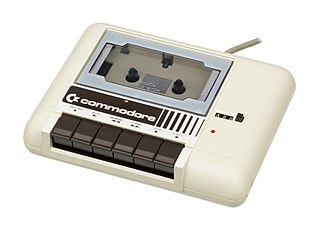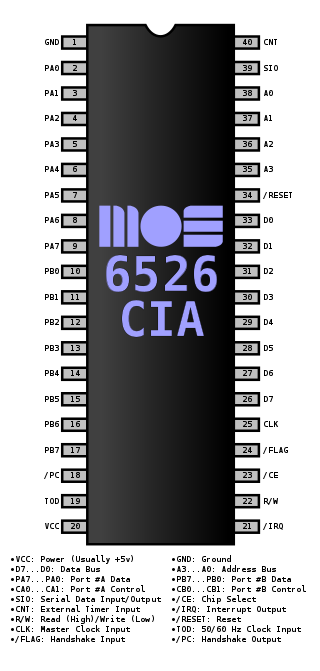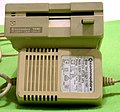
The Commodore 1541 is a floppy disk drive which was made by Commodore International for the Commodore 64 (C64), Commodore's most popular home computer. The best-known floppy disk drive for the C64, the 1541 is a single-sided 170-kilobyte drive for 5¼" disks. The 1541 directly followed the Commodore 1540.

The Commodore 1581 is a 3½-inch double-sided double-density floppy disk drive that was released by Commodore Business Machines (CBM) in 1987, primarily for its C64 and C128 home/personal computers. The drive stores 800 kilobytes using an MFM encoding but formats different from the MS-DOS, Amiga, and Mac Plus formats. With special software it's possible to read C1581 disks on an x86 PC system, and likewise, read MS-DOS and other formats of disks in the C1581, provided that the PC or other floppy handles the "720 kB" size format. This capability was most frequently used to read MS-DOS disks. The drive was released in the summer of 1987 and quickly became popular with bulletin board system (BBS) operators and other users.

The Commodore 1571 is Commodore's high-end 5¼" floppy disk drive, announced in the summer of 1985. With its double-sided drive mechanism, it has the ability to use double-sided, double-density (DS/DD) floppy disks, storing a total of 360 kB per floppy. It also implemented a "burst mode" that improved transfer speeds, helping address the very slow performance of previous Commodore drives.

The Commodore PET is a line of personal computers produced starting in 1977 by Commodore International. A single all-in-one case combines a MOS Technology 6502 microprocessor, Commodore BASIC in read-only memory, keyboard, monochrome monitor, and, in early models, a cassette deck.

IEEE 488, also known as HP-IB and generically as GPIB, is a short-range digital communications 8-bit parallel multi-master interface bus specification developed by Hewlett-Packard. It subsequently became the subject of several standards.

The Commodore 1530 (C2N) Datasette, later also Datassette, is Commodore's dedicated magnetic-tape data storage device. Using compact cassettes as the storage medium, it provides inexpensive storage to Commodore's 8-bit computers, including the PET, VIC-20, and Commodore 64. A physically similar model, Commodore 1531, was made for the Commodore 16 and Plus/4 series computers.

The HP-IL was a short-range interconnection bus or network introduced by Hewlett-Packard in the early 1980s. It enabled many devices such as printers, plotters, displays, storage devices, test equipment, etc. to be connected to programmable calculators such as the HP-41C, HP-71B and HP-75C/D, the Series 80 and HP-110 computers, as well as generic ISA bus based PCs.

The Commodore 65 is a prototype computer created at Commodore Business Machines in 1990–1991. It is an improved version of the Commodore 64, and it was meant to be backwards-compatible with the older computer, while still providing a number of advanced features close to those of the Amiga.

The Commodore CBM-II series is a short-lived range of 8-bit personal computers from Commodore Business Machines (CBM), released in 1982 and intended as a follow-on to the Commodore PET series.

Commodore DOS, also known as CBM DOS, is the disk operating system used with Commodore's 8-bit computers. Unlike most other DOSes, which are loaded from disk into the computer's own RAM and executed there, CBM DOS is executed internally in the drive: the DOS resides in ROM chips inside the drive, and is run there by one or more dedicated MOS 6502 family CPUs. Thus, data transfer between Commodore 8-bit computers and their disk drives more closely resembles a local area network connection than typical disk/host transfers.

Profinet is an industry technical standard for data communication over Industrial Ethernet, designed for collecting data from, and controlling equipment in industrial systems, with a particular strength in delivering data under tight time constraints. The standard is maintained and supported by Profibus and Profinet International, an umbrella organization headquartered in Karlsruhe, Germany.

The 6526/8520 Complex Interface Adapter (CIA) was an integrated circuit made by MOS Technology. It served as an I/O port controller for the 6502 family of microprocessors, providing for parallel and serial I/O capabilities as well as timers and a Time-of-Day (TOD) clock. The device's most prominent use was in the Commodore 64 and Commodore 128(D), each of which included two CIA chips. The Commodore 1570 and Commodore 1571 floppy disk drives contained one CIA each. Furthermore, the Amiga home computers and the Commodore 1581 floppy disk drive employed a modified variant of the CIA circuit called 8520. 8520 is functionally equivalent to the 6526 except for the simplified TOD circuitry. Predecessor to CIA was PIA.

The Commodore 64 home computer used various external peripherals. Due to the backwards compatibility of the Commodore 128, most peripherals would also work on that system. There is also some compatibility with the VIC-20 and Commodore PET.

The MSD Super Disk were a series of 5¼-inch floppy disk drives compatible to some degree with the Commodore 1541 disk drive. produced by Micro Systems Development for use with Commodore 8-bit home computers. Two different versions of the MSD Super Disk were available: the single-drive model, SD-1; and the dual-drive model, SD-2.
EtherCAT is an Ethernet-based fieldbus system developed by Beckhoff Automation. The protocol is standardized in IEC 61158 and is suitable for both hard and soft real-time computing requirements in automation technology.

The Standard Commands for Programmable Instruments defines a standard for syntax and commands to use in controlling programmable test and measurement devices, such as automatic test equipment and electronic test equipment.

Batteries Included was a computer software and hardware company based in the Toronto area. It developed products for the Apple II, Atari 8-bit computers, Atari ST, Commodore 64, and MS-DOS. The company was best known in the 1980s for its PaperClip word processor, which was available for the Atari 8-bit family and Commodore 64, and the DEGAS bitmap painting program for the Atari ST. Batteries Included was acquired by Electronic Arts in 1987.
Commodore 64 disk/tape emulation and data transfer comprises hardware and software for Commodore 64 disk & tape emulation and for data transfer between either Commodore 64 (C64), Commodore (1541) disk drive or Commodore tape deck and newer computers.

The Commodore D9060/D9090 Hard Disks were the only family of hard drives that Commodore made for both the home and business market. The electronics are identical in the D9060 and the larger D9090 unit; the only difference is the size of the installed hard drive, with a jumper set to distinguish between 4 or 6 disk heads. Originally intended for the metal-cased PET/CBM series of computers, they are compatible with the VIC-20, Commodore 64 and later models with an adapter.

Audio Video Bridging (AVB) is a common name for a set of technical standards that provide improved synchronization, low latency, and reliability for switched Ethernet networks. AVB embodies the following technologies and standards:
























